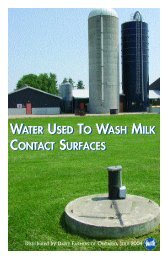Canadian Quality Milk On-Farm Food Safety Program - Centre ...
Canadian Quality Milk On-Farm Food Safety Program - Centre ...
Canadian Quality Milk On-Farm Food Safety Program - Centre ...
Create successful ePaper yourself
Turn your PDF publications into a flip-book with our unique Google optimized e-Paper software.
<strong>Canadian</strong> <strong>Quality</strong> <strong>Milk</strong><br />
7.2 MILK HOUSE<br />
The milk house is the final on-farm site for quality control. The<br />
The milk house is often<br />
following Best Management Practices should be followed in the the first area that visitors<br />
milk house:<br />
(consumers) see when<br />
Use it exclusively for cooling and storing milk, and for<br />
touring or driving by your<br />
dairy operation. That first<br />
cleaning, sanitizing and storing materials and equipment used<br />
impression can determine<br />
in the production and handling of milk. If other items are stored their overall perception of<br />
in the milk house, they must not pose a food safety hazard. the quality and cleanliness<br />
Store approved chemicals and products used in the milk house of your product.<br />
in a location and manner that will not contaminate milk. Also<br />
ensure that containers are in good condition and properly labelled (e.g. to be<br />
compatible with the cleaning and sanitizing chart).<br />
Ensure the milk house and external surfaces of the milking and milk storage<br />
equipment are kept clean (e.g. bulk tank and gasket around man-hole must be<br />
clean; milk house must be free of unnecessary clutter).<br />
A functioning safety switch or fail-safe system (for Automatic <strong>Milk</strong>ing Systems) must<br />
be in place to avoid accidental entry of water and cleaning chemicals into the milk.<br />
The safety switches prevent the wash system from turning on unless the swing pipe<br />
is removed from the bulk tank. If you have a manually operated clean-in-place (CIP)<br />
system, you must have a safety device as well (e.g. plug for the sink is attached to<br />
the swing pipe so that sink cannot be plugged unless the swing pipe is detached<br />
from the bulk tank).<br />
Remove all mercury thermometers or vacuum columns from the milk house. Mercury<br />
vacuum gauges can be replaced by mercury-free dial or digital gauges, which do not<br />
pose a health risk. Please contact your local hazardous waste depot to dispose<br />
of any mercury thermometers or vacuum gauges! Even if a mercury<br />
thermometer or vacuum gauge is not in use, it still must be removed.<br />
Ensure that any lights located near the man-hole on the bulk tank have protective<br />
coverings or that the bulbs have a protective safety coating.<br />
Broken glass from lights located near the man-hole on the bulk tank is another<br />
hazard to stored milk. Some milk houses have low roofs and long dip-sticks,<br />
increasing the possibility that the milk truck driver will smash a light when checking<br />
the level of the milk in the bulk tank. Florescent tubes have also been known burst<br />
on their own. It is also recommended to cover lights located near the wash sink.<br />
Ensure clear drains in milking centre. <strong>Milk</strong> room drains must handle milking<br />
equipment and bulk tank wash water. They must have an easily cleaned gas trap to<br />
keep waste odours out of the milk house and milking centre. Drains should be<br />
cleaned regularly to avoid blockage of the drain. It is recommended that drains be<br />
located a minimum of 60 cm (2 feet) away from the outlet of the bulk tank and not be<br />
placed under the tank (this is regulation in some provinces). This allows for easy<br />
access and avoids contamination of the tank outlet.<br />
7—10<br />
June 2010
















